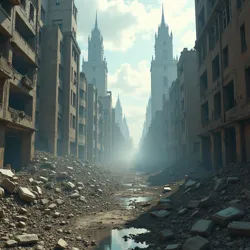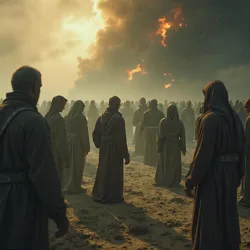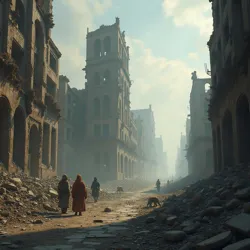Great Shattering

Planetary devastation is depicted after the Great Shattering, showcasing fractured landscapes and a stormy sky.
Great Shattering
global cataclysm
societal collapse
environmental devastation
spiritual upheaval
days to weeks
Years of Woe
The *Great Shattering* was a cataclysmic global event that dramatically reshaped the planet, leading to widespread environmental devastation, societal collapse, and a profound spiritual upheaval. Referred to in hushed tones and fragmented accounts, the Great Shattering marks a definitive turning point in history, separating the pre-cataclysmic era from the post-Shattering world in which figures like Aerion Lumina operate. The precise nature of the Shattering remains shrouded in mystery, with surviving records incomplete and often contradictory, contributing to an aura of both historical and existential uncertainty that permeates the cultures of the affected regions, most notably the Shattered Coast. This event is not merely a historical marker; its lingering effects continue to shape the physical, spiritual, and social landscapes of the world.
Nature of the Shattering
Conflicting Accounts and Theories
 Cityscape ruins are shown with collapsed buildings and debris, highlighting the physical destruction.
Cityscape ruins are shown with collapsed buildings and debris, highlighting the physical destruction.The Great Shattering is characterized by a fundamental lack of consensus regarding its precise cause and mechanisms. Unlike well-documented historical events, the Shattering left behind a legacy of fragmented narratives, whispered rumors, and a scarcity of reliable data. Pre-Shattering record-keeping systems, already faltering in many regions due to escalating environmental and societal pressures, were largely obliterated in the cataclysm. Oral histories and fragmented texts passed down through generations are rife with inconsistencies, often blending factual accounts with mythologized interpretations.
Several competing theories attempt to explain the Shattering, each with varying degrees of plausibility and evidentiary support:
-
Geophysical Cataclysm: This theory posits that the Shattering was triggered by a series of extreme natural disasters of unprecedented scale. Proponents suggest a convergence of tectonic plate shifts leading to massive earthquakes and volcanic eruptions across the globe. These seismic events, in turn, are believed to have triggered colossal tsunamis that inundated coastal regions, and destabilized the atmosphere, leading to radical climate shifts and prolonged periods of environmental chaos. Some variations of this theory incorporate the idea of a rogue asteroid or comet impact as the initial catalyst, setting off a chain reaction of geophysical instability.
-
Technological Cascade Failure: Another prominent theory attributes the Shattering to a catastrophic failure of pre-Shattering technology. This perspective highlights humanity's increasing reliance on complex and interconnected technological systems, particularly in areas of energy production, communication, and environmental control. According to this theory, a critical system malfunction, perhaps triggered by a solar flare, a widespread computer virus, or an unforeseen consequence of advanced scientific experimentation, initiated a cascading failure across multiple interconnected networks. This breakdown resulted in widespread power outages, communication blackouts, and the collapse of essential infrastructure, leading to societal breakdown and further environmental damage as unchecked technological processes spiraled out of control.
-
Spiritual or Esoteric Upheaval: A less empirically verifiable, yet widely held belief, especially within shamanic and spiritual communities like the Silvanesti lineage, attributes the Shattering to a profound spiritual or esoteric disruption. This theory suggests that the pre-Shattering world had become spiritually imbalanced, perhaps due to humanity's alienation from nature, unchecked technological hubris, or the influence of malevolent spiritual entities. The Shattering, in this context, is seen as a form of planetary purification or a violent re-balancing of spiritual energies, resulting in both physical and psychic repercussions. Some proponents of this theory suggest the involvement of previously unknown or dormant astral entities whose awakening or intervention triggered the cataclysm.
-
Combined Causality: Recognizing the limitations of any single explanation, some scholars propose a combined causality model. This perspective suggests that the Shattering was likely the result of multiple converging factors. For instance, a geophysical event, such as a major volcanic eruption, could have triggered a technological system failure, which in turn amplified the Spiritual Malaise already present in the world, leading to a synergistic and exponentially more devastating outcome. This multifaceted approach acknowledges the complexity of the event and the interconnectedness of physical, technological, and spiritual realms.
The lack of definitive answers regarding the Shattering's nature contributes to the pervasive sense of unease and uncertainty in the post-cataclysmic world. Communities grapple not only with the physical scars of the event but also with the lingering epistemological void, the inability to fully comprehend the disaster that fundamentally altered their reality.
Physical Devastation
Regardless of its precise cause, the Great Shattering resulted in widespread physical devastation across the globe. The immediate aftermath was characterized by:
-
Seismic and Volcanic Activity: Earthquakes of immense magnitude leveled cities and triggered landslides, while volcanic eruptions spewed ash and toxic gases into the atmosphere, further disrupting climate patterns and rendering vast areas uninhabitable. The Appalachian Mountains, while offering some refuge due to their geological stability, still experienced significant seismic shifts and volcanic fallout.
-
Tsunamis and Sea Level Rise: Coastal regions were particularly hard hit by massive tsunamis, some reaching hundreds of feet in height, which swept inland, obliterating coastal settlements and reshaping coastlines. Furthermore, the Shattering precipitated a significant and rapid rise in sea levels, submerging low-lying areas and forcing populations to retreat inland. The eastern seaboard of North America, now known as the Shattered Coast, experienced a particularly dramatic transformation, with major cities like New York City and Boston largely submerged or rendered uninhabitable.
-
Environmental Degradation: The Shattering unleashed a cascade of environmental disasters. Industrial facilities and power plants, damaged or destroyed, released vast quantities of pollutants into the air, water, and soil. Nuclear facilities, where they existed, posed a particularly grave threat, with some suffering meltdowns or breaches, contaminating large areas with ionizing radiation. Deforestation, desertification, and the disruption of ecosystems further exacerbated the environmental crisis, leading to widespread famine and resource scarcity.
-
Infrastructure Collapse: Essential infrastructure, including transportation networks, communication systems, and power grids, was decimated by the Shattering. Roads and bridges crumbled, communication lines were severed, and power generation ceased in many areas. This infrastructural collapse severely hampered recovery efforts and contributed to the fragmentation of societies, isolating communities and hindering the flow of resources and information.
The physical landscape of the post-Shattering world is thus one of ruins and scars, a constant reminder of the scale of the cataclysm. Survivors live amidst the remnants of a lost civilization, constantly contending with the lingering effects of environmental contamination, unstable terrain, and the challenges of rebuilding in a world fundamentally altered by destruction.
Spiritual and Psychic Impact
Beyond the tangible physical devastation, the Great Shattering inflicted a profound and pervasive spiritual and psychic wound upon the world. This less visible, yet equally impactful dimension of the cataclysm is central to understanding the context in which spiritmenders like Aerion Lumina operate. The spiritual and psychic consequences of the Shattering included:
-
Spiritual Malaise: A widespread and debilitating sense of spiritual sickness, often referred to as spiritual malaise, became prevalent in the post-Shattering world. This malaise manifests as a pervasive feeling of emptiness, despair, disconnection, and a loss of meaning or purpose. It affects individuals and communities alike, undermining morale, hindering social cohesion, and contributing to psychological distress and even physical illness. Aerion Lumina's spiritmending practice is specifically designed to address this pervasive spiritual affliction.
-
Fraying of the Spiritual Fabric: Many spiritual traditions, including the Silvanesti, describe the Shattering as having frayed or torn the very fabric of the spiritual world. This metaphorical description suggests a disruption of the interconnectedness between the physical and spiritual realms, leading to a sense of spiritual fragmentation and instability. The boundaries between worlds may have become blurred, allowing for increased intrusion from unsettling spiritual entities or the manifestation of psychic phenomena.
-
Psychic Trauma and Fragmentation: The sheer trauma of the Shattering, experienced by individuals and collectively by humanity, left deep psychic scars. This widespread trauma contributed to phenomena such as soul fragmentation, where aspects of an individual's soul or psychic energy become detached as a coping mechanism in response to overwhelming experiences. This fragmentation can manifest as emotional numbness, memory loss, personality changes, and a diminished sense of self. Soul retrieval, as practiced by Aerion, is a response to this specific form of psychic wounding.
-
Emergence of New Spiritual Phenomena: The Shattering, while destructive, also acted as a catalyst for the emergence of new spiritual phenomena. The disruption of the spiritual landscape may have created openings for new forms of spiritual energy to manifest or for previously dormant psychic abilities to awaken. The appearance of Dragon-veined individuals like Ignia Drakon is sometimes linked to these spiritual shifts, suggesting that the Shattering not only wounded but also transformed the spiritual potential of humanity.
The spiritual and psychic wounds of the Shattering are less easily quantifiable than the physical devastation, but they are no less real. They represent a profound challenge for survivors, requiring not only physical rebuilding but also spiritual and psychological healing on a massive scale. The work of spiritmenders like Aerion is crucial in addressing this often overlooked but deeply significant dimension of the post-Shattering world.
Timeline and Geographic Scope
Chronology of Events
 Individuals in despair are depicted, representing the widespread spiritual emptiness after the cataclysm.
Individuals in despair are depicted, representing the widespread spiritual emptiness after the cataclysm.Pinpointing the precise timeline of the Great Shattering is complicated by the destruction of records and the fragmented nature of surviving accounts. However, a general chronological framework can be reconstructed from available sources:
-
Pre-Shattering Era: This period, preceding the cataclysm, was characterized by increasing environmental instability, growing social unrest, and a sense of impending crisis. While technological advancement continued in some areas, there were also signs of societal strain and a growing awareness of ecological limits. Spiritual traditions, like the Silvanesti, may have sensed a growing imbalance in the world, though the precise nature of the coming disaster remained unclear.
-
The Shattering Event (The "Day of Calamity"): The Shattering itself is often described as a relatively short but intensely destructive period, sometimes referred to as the "Day of Calamity" in surviving oral traditions. This phase likely involved the peak of seismic and volcanic activity, the most devastating tsunamis, and the initial collapse of major infrastructure. The duration of this peak phase remains debated, with estimates ranging from a few days to several weeks, depending on the region and the specific impacts being considered.
-
Immediate Aftermath (The "Years of Woe"): Following the initial cataclysm, the world entered a prolonged period of chaos and instability, often termed the "Years of Woe." This era was marked by widespread famine, disease outbreaks, resource wars, and the breakdown of social order. Environmental conditions remained volatile, with unpredictable weather patterns, lingering pollution, and the ongoing threat of natural disasters. Survivor Communities struggled to establish themselves amidst the ruins, facing constant threats from both the environment and other desperate survivors.
-
Post-Shattering Present (The "Age of Reclamation"): Centuries after the initial Shattering, the world remains profoundly changed, but a degree of stability has gradually returned in some regions. Survivor communities have evolved, adapting to the new realities and developing unique post-cataclysmic cultures. Technological knowledge from the pre-Shattering era is fragmented and selectively preserved, with a greater emphasis on sustainable and resilient technologies. Spiritual traditions have experienced a resurgence, with practices like spiritmending gaining prominence as a means of healing and restoring balance in a wounded world. This era is sometimes optimistically referred to as the "Age of Reclamation," reflecting the ongoing efforts to rebuild societies and reclaim a sense of normalcy, though the shadow of the Shattering remains ever-present.
This chronological framework is not uniformly applicable across the globe, as different regions experienced the Shattering and its aftermath in varying ways. However, it provides a general context for understanding the historical progression from the pre-cataclysmic world to the post-Shattering present.
Global Reach, Localized Impacts
The Great Shattering was undeniably a global event, affecting every continent and impacting interconnected systems on a planetary scale. Evidence of widespread devastation, environmental disruption, and societal collapse can be found in archaeological records and surviving accounts from across the globe. However, the intensity and specific nature of the Shattering's impacts varied significantly from region to region.
Factors contributing to these localized variations included:
-
Geographical Vulnerability: Regions prone to seismic activity, volcanic eruptions, or coastal inundation were naturally more susceptible to the immediate physical impacts of the Shattering. For example, areas along major fault lines or low-lying coastal plains experienced disproportionately severe devastation.
-
Pre-Shattering Infrastructure and Preparedness: Regions with more robust infrastructure, well-established disaster preparedness systems, and greater social cohesion were better equipped to withstand the initial shock and initiate recovery efforts. However, even the most advanced societies were ultimately overwhelmed by the scale of the cataclysm.
-
Environmental Resilience: Some ecosystems proved more resilient to the environmental disruptions of the Shattering than others. Regions with greater biodiversity, more stable climates, or access to essential resources were better able to support surviving populations and facilitate long-term recovery.
-
Cultural and Social Adaptation: Pre-existing cultural traditions, social structures, and levels of community cooperation played a significant role in how different populations responded to the Shattering. Societies with strong communal bonds, adaptable cultural practices, and a history of resilience in the face of adversity were better positioned to navigate the challenges of the post-cataclysmic world.
As a result of these localized variations, the post-Shattering world is characterized by a mosaic of diverse regional outcomes. Some areas experienced near-total societal collapse and environmental ruin, while others managed to maintain a degree of continuity and initiate more rapid recovery. The Shattered Coast, as described in the context of Aerion Lumina, represents a region that experienced a particularly severe combination of physical and spiritual devastation, while other areas may have fared comparatively better, though none escaped the global reach of the cataclysm entirely.
The Eastern Seaboard as "Shattered Coast"
The eastern seaboard of the former United States, now widely known as the Shattered Coast, exemplifies a region that suffered exceptionally severe and multifaceted impacts from the Great Shattering. The designation "Shattered Coast" is not merely descriptive of the physical landscape but also reflects the profound spiritual and societal fragmentation that characterizes the region.
Several factors contributed to the particularly devastating impact on this area:
-
Coastal Vulnerability: The low-lying coastal plains of the eastern seaboard were directly exposed to the full force of Shattering-induced tsunamis and sea level rise. Major coastal cities, densely populated and vital centers of pre-Shattering civilization, were largely submerged or destroyed, resulting in immense loss of life and infrastructure.
-
Industrial and Technological Concentration: The eastern seaboard was a major hub of pre-Shattering industry and technology. The collapse of this infrastructure released vast quantities of pollutants into the environment, exacerbating the environmental crisis and creating long-lasting toxic legacies. The concentration of nuclear power plants in this region also posed a significant threat, with potential for widespread radioactive contamination.
-
Social and Economic Disruption: The densely populated and highly interconnected societies of the eastern seaboard were particularly vulnerable to the social and economic disruptions caused by the Shattering. The breakdown of supply chains, communication networks, and governance structures led to widespread social unrest, resource scarcity, and the emergence of violent factions vying for control.
-
Spiritual Resonance: Some esoteric theories suggest that the eastern seaboard, with its complex history and diverse cultural influences, may have been a region particularly susceptible to the spiritual disruptions of the Shattering. Pre-existing spiritual tensions or imbalances in the region may have amplified the spiritual malaise and psychic trauma unleashed by the cataclysm.
The term "Shattered Coast" thus encapsulates not only the physical devastation of the coastline but also the deeper fragmentation of society, culture, and spirit in this region. It is a landscape of ruins and resilience, where survivors grapple with both tangible and intangible wounds, seeking to rebuild amidst the lingering shadows of the Great Shattering. The journey of Aerion Lumina through this region, offering spiritmending and hope, is emblematic of the ongoing struggle for healing and renewal in the face of profound loss and fragmentation.
Societal and Cultural Aftermath
Collapse of Civilization and Rise of New Orders
 A small community of survivors is shown rebuilding their lives amidst the ruins of the old world.
A small community of survivors is shown rebuilding their lives amidst the ruins of the old world.The Great Shattering precipitated a near-universal collapse of pre-Shattering civilizations. The complex social, political, and economic structures that characterized the world before the cataclysm proved unable to withstand the scale of the disaster and its aftermath. This collapse manifested in various ways:
-
Breakdown of Governance: Centralized governments, already weakened in many regions by pre-Shattering crises, largely disintegrated in the face of the Shattering. Communication breakdowns, infrastructure collapse, and the sheer scale of the disaster overwhelmed existing administrative capacities. Authority fragmented, with power devolving to local warlords, community leaders, or simply the most ruthless and resourceful individuals.
-
Economic Devastation: Globalized economic systems collapsed as trade routes were disrupted, industries were destroyed, and resources became scarce. Pre-Shattering currencies lost their value, and barter systems or localized resource-based economies emerged in their place. Survival became the primary economic imperative, with communities focused on securing basic necessities like food, water, and shelter.
-
Social Fragmentation: Societies fractured along various lines – geographic, ethnic, ideological – as pre-Shattering social bonds weakened under the strain of survival. Distrust and competition for resources became pervasive, leading to conflict and hindering cooperative rebuilding efforts. Family units and small communities often became the primary units of social organization, offering mutual support in a chaotic world.
-
Emergence of New Social Orders: Amidst the collapse, new forms of social organization began to emerge, often adapted to the harsh realities of the post-Shattering world. These included:
-
Survivor Communities: Groups of individuals who banded together for mutual protection and resource sharing. These communities varied widely in size, structure, and ideology, ranging from egalitarian collectives to hierarchical strongholds ruled by charismatic leaders.
-
Raider Factions: Organized groups that preyed on weaker communities, seizing resources and enforcing their dominance through violence. Raiders thrived in the lawless environments of the post-Shattering world, exploiting the vulnerability of isolated settlements.
-
Nomadic Groups: Populations that adopted a nomadic or semi-nomadic lifestyle, following seasonal resource availability or migrating in search of more hospitable environments. Nomadic groups often developed specialized skills in survival, foraging, and adaptation to changing landscapes.
-
Cultic Movements: Spiritual and ideological movements that arose in response to the Shattering, offering explanations for the cataclysm, promising salvation, or advocating for specific social or spiritual orders. Some cultic movements were benign and community-focused, while others were authoritarian and exploitative.
-
The societal landscape of the post-Shattering world is thus a complex tapestry of collapse and regeneration, fragmentation and re-organization. Pre-Shattering civilization is gone, replaced by a diverse array of new social orders, each struggling to survive and define its place in a world fundamentally transformed by disaster.
Technological Regression and Adaptation
The Great Shattering resulted in a significant technological regression across the globe. The destruction of infrastructure, loss of knowledge, and scarcity of resources led to a widespread decline in technological capabilities. However, this regression was not uniform or absolute. Instead, it was accompanied by a process of adaptation, innovation, and selective preservation of pre-Shattering technologies.
-
Loss of Advanced Technology: Highly complex and specialized technologies, requiring intricate manufacturing processes, global supply chains, and specialized knowledge, were largely lost or rendered unusable in the aftermath of the Shattering. Examples include advanced electronics, sophisticated medical equipment, and large-scale industrial machinery.
-
Dependence on Simpler Technologies: Survival in the post-Shattering world necessitated a reliance on simpler, more robust, and readily maintainable technologies. Basic tools, handcrafts, agriculture, and renewable energy sources became increasingly important. Skills in repair, improvisation, and resourcefulness were highly valued.
-
Selective Preservation of Knowledge: While much pre-Shattering technological knowledge was lost, some communities actively sought to preserve and transmit what they could. Monasteries, libraries, and oral traditions became repositories of fragmented scientific and technical information. The Silvanesti, with their emphasis on traditional knowledge and connection to nature, may have played a role in preserving certain forms of ecological and herbal knowledge.
-
Post-Shattering Innovation: Necessity spurred innovation in the post-Shattering world. Survivors developed new techniques and technologies adapted to the changed environment and the scarcity of resources. Examples include new forms of sustainable agriculture, water purification methods, and resilient building materials. Chordwrights, though not directly related to technology in a mechanical sense, represent a form of post-Shattering innovation in the realm of spiritual technology, developing new ways to interact with soleric energy and the spiritual world.
Technological regression in the post-Shattering world is thus not simply a story of loss, but also one of adaptation and rediscovery. While the technological sophistication of the pre-Shattering era is gone, survivors have learned to live with simpler means, innovate in response to new challenges, and selectively preserve and adapt knowledge from the past. This technological landscape is characterized by a greater emphasis on sustainability, resilience, and localized self-sufficiency, a stark contrast to the complex and often unsustainable technologies of the pre-Shattering world.
Spiritual and Shamanic Revival
In the wake of the Great Shattering, spiritual and shamanic traditions experienced a significant revival and resurgence. The profound spiritual malaise, psychic trauma, and societal fragmentation created a widespread need for healing, meaning, and connection, which traditional religious and secular institutions were often ill-equipped to address. Shamanic practices, with their emphasis on direct spiritual experience, nature-based wisdom, and personalized healing, offered a compelling alternative.
-
Addressing Spiritual Malaise: Practices like spiritmending, developed by figures like Aerion Lumina, directly address the pervasive spiritual malaise that afflicts post-Shattering communities. These practices offer a means of restoring spiritual vitality, reconnecting individuals to a sense of purpose, and alleviating the emotional and psychic burdens of trauma.
-
Soul Retrieval and Psychic Healing: Soul retrieval and other shamanic healing techniques provide targeted interventions for individuals suffering from psychic trauma and soul fragmentation, direct consequences of the Shattering. These practices offer a path towards psychological integration and emotional healing in a world marked by widespread trauma.
-
Reconnection with Nature: Shamanic traditions, deeply rooted in reverence for nature and the interconnectedness of all living things, offer a vital counterbalance to the technological hubris and environmental alienation that may have contributed to the Shattering. Reconnecting with nature is seen as a source of healing, resilience, and spiritual renewal.
-
Community Building and Social Cohesion: Shamanic rituals and ceremonies often serve as important community-building activities in the post-Shattering world. They provide shared experiences, foster social bonds, and reinforce collective values, helping to rebuild social cohesion in fragmented communities.
-
Adaptation and Innovation within Shamanism: The spiritual revival is not simply a return to pre-Shattering shamanic practices. Shamanic traditions have demonstrated a capacity for adaptation and innovation, evolving to address the unique challenges of the post-Shattering world. Aerion Lumina's spiritmending, with its synthesis of Silvanesti tradition and adaptive techniques, exemplifies this dynamic evolution.
The spiritual and shamanic revival in the post-Shattering world is thus a multifaceted phenomenon, driven by a deep need for healing, meaning, and connection in the face of profound loss and disruption. Figures like Aerion Lumina are at the forefront of this revival, offering not just individual healing but also contributing to the spiritual and social rebuilding of shattered communities.